Disrupted association between functional connectivity and structural connectivity in Alzheimer’s disease
By Y. Sun, J. Sun, N. Thakor, & A. Bezerianos
Alzheimer’s Disease (AD) is associated with abnormal wiring (or structural connectivity) in the brain. This project is a novel investigation into the relationship of this abnormal wiring to the functional connectivity of neural populations in healthy subjects and AD patients.
Alzheimer’s disease (AD) is a neurodegenerative disease clinically characterized by progressive dementia and neuropsychiatric symptoms include confusion, aggression, language breakdown and loss of cognitive functions [1, 2]. Accumulating evidence suggests that these cognitive dysfunctions may result from abnormal wiring of the brain’s network [3]. Although there are widespread atrophy and abnormal structural connectivity in AD-related pathological regions, how the abnormality of structural connectivity would affect the corresponding functional connectivity is still limitedly understood.
Two neural populations are considered to be functionally connected if their representative neuronal activities are temporally coherent, while the structural connectivity provides putative bundle pathways of macroscopic white matter fibers linking cortical areas.
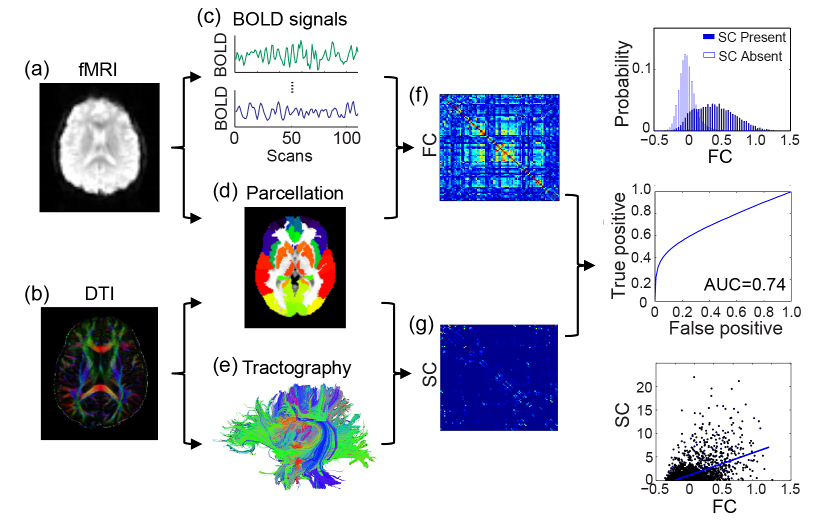
Figure 1: Flowchart of the analysis steps. After preprocessing, each subject’s fMRI images (a) were registered to the ICBM152 template and parcellated according to the AAL-90 template (d). Representative time series (BOLD signals, (c)) of each ROI was obtained by averaging the time series of each voxel within that region. Pearson correlation coefficient was calculated between all possible pairs of ROIs to obtain the functional connectivity (FC) network (f). Subject’s structural connectivity (SC, (g)) was estimated from DTI images (b) through tractography (e). The overall FC-SC relationships were estimated through (1) the probability densities of FC between structurally connected and unconnected regions pairs; (2) ROC curves when inferring SC by thresholding FC; and (3) correlation between the FC and SC strengths.
Because the propensity for two neuron populations to interact should vary, at least in part, to the density and efficacy of the neuronal projections connecting them [4], it makes sense to assume that the repertoire of functional configurations and interactions is reflective of underlying anatomical linkage [5]. The emerging field of combining both functional and structural brain networks has provided some of the first quantitative insights to better understand abnormal association between structural and functional connectivity in brain with neurological and psychiatric disorders, which might significantly advance our diagnostic and prognostic capacities [6, 7].
In this work, we measured functional connectivity (FC) based on resting-state fMRI data and structural connectivity (SC) through diffusion tensor imaging (DTI) in 14 healthy subjects (M/F=6/8, age=68.6±8.4 years) and 12 AD patients (M/F=4/8, age=73.1±7.9). The FC-SC relationship was assessed through examining the probability densities of FC when the SC counterparts were present or absent. We then tested the accuracy of inferring SC via thresholding FC. Finally, we quantified the relationship between FC and SC through calculating the correlation coefficient between all nonzero entries of the SC matrix and FC matrix.
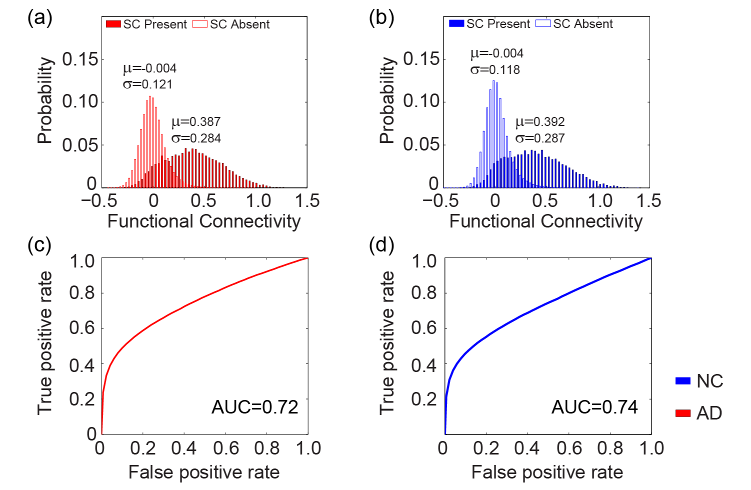
Figure 2: The overall FC-SC relationships. The probability densities of FC strengths between structurally connected and unconnected regions pairs in (a) AD patients and (b) healthy subjects. When direct SC presents, higher FC strength appears than the case direct SC absents, indicating a robust relationship between FC and SC. When inferring SC through thresholding FC values, we found the predicting accuracies in both groups ((c) & (d)) are not satisfactory.
As shown in Figure 2, for both healthy subjects and AD patients, when direct SCs are present, the strength of FC is evidently larger than 0 for both groups (μ>0); while when direct SCs are absent, the strength of FC varies over a wide range around 0 (μ˜0). These results are consistent with observations demonstrated in [4, 8, 9]. Nonetheless, when inferring the presence of SC through thresholding FC values, the prediction was not reliable. These two observations together suggest that functional connectivity is reflective of the underlying structural connectivity architecture but not a simple one-to-one relationship [4, 6]. More interestingly, a decreased association between FC and SC was observed in AD patients (AD vs. NC, p < 0.01). To our knowledge, it is the first work demonstrating that AD related brain dysfunctions can be characterized by profiles of FC-SC relationship.
In addition to this pilot study, we are further examining the evolution of FC-SC relationship in AD patients, taking mild cognitive impairment (MCI) patients into consideration. MCI is generally considered as a certain mid-stage between normal aging and AD and has a high risk to progress into AD [10]. Study on AD and MCI patients with multiple follow-ups are highly expected to verify the evolution of SC-FC relationship in AD and MCI patients, which may provide new insights to the pathological mechanism of AD and advance its early diagnostic and prognostic based on neuroimage techniques.
Acknowledgements
This study was supported by Med-X Research Fund of Shanghai Jiao Tong University (No. YG2012MS09).
For Further Reading
1. B. Dubois, H. H. Feldman, C. Jacova, et al., “Revising the definition of Alzheimer’s disease: a new lexicon,” Lancet Neurol., vol. 9, no. 11, pp. 1118-27, Nov, 2010.
2. C. Sorg, V. Riedl, M. Muhlau, et al., “Selective changes of resting-state networks in individuals at risk for Alzheimer’s disease,” Proc. Natl. Acad. Sci. USA, vol. 104, no. 47, pp. 18760-5, Nov 20, 2007.
3. X. Delbeuck, M. Van der Linden, and F. Collette, “Alzheimer’s disease as a disconnection syndrome?,” Neuropsychol. Rev., vol. 13, no. 2, pp. 79-92, Jun, 2003.
4. C. J. Honey, O. Sporns, L. Cammoun, et al., “Predicting human resting-state functional connectivity from structural connectivity,” Proc. Natl. Acad. Sci. USA, vol. 106, no. 6, pp. 2035-40, Feb 10, 2009.
5. R. E. Passingham, K. E. Stephan, and R. Kotter, “The anatomical basis of functional localization in the cortex,” Nat. Rev. Neurosci., vol. 3, no. 8, pp. 606-16, Aug, 2002.
6. J. S. Damoiseaux, and M. D. Greicius, “Greater than the sum of its parts: a review of studies combining structural connectivity and resting-state functional connectivity,” Brain Struct. Funct., vol. 213, no. 6, pp. 525-533, Oct, 2009.
7. M. Guye, F. Bartolomei, and J. P. Ranjeva, “Imaging structural and functional connectivity: towards a unified definition of human brain organization?,” Curr Opin Neurol, vol. 21, no. 4, pp. 393-403, Aug, 2008.
8. M. P. van den Heuvel, and H. E. Hulshoff Pol, “Exploring the brain network: a review on resting-state fMRI functional connectivity,” Eur. Neuropsychopharmacol., vol. 20, no. 8, pp. 519-34, Aug, 2010.
9. M. P. van den Heuvel, R. C. Mandl, R. S. Kahn, et al., “Functionally linked resting-state networks reflect the underlying structural connectivity architecture of the human brain,” Hum. Brain Mapp., vol. 30, no. 10, pp. 3127-41, Oct, 2009.
10. R. C. Petersen, G. E. Smith, S. C. Waring, et al., “Mild cognitive impairment: clinical characterization and outcome,” Arch. Neurol., vol. 56, no. 3, pp. 303-8, Mar, 1999.
Contributors
 Y. Sun (M’13) is a Research Fellow in the Singapore Institute for Neurotechnology (SINAPSE) at the National University of Singapore. Dr. Sun received his PhD degree in Electronics, Electricals, and System Engineering from Loughborough University, UK, in 2011 and the PhD degree in Biomedical Engineering from Shanghai Jiao Tong University, China, in 2012 respectively. Read more
Y. Sun (M’13) is a Research Fellow in the Singapore Institute for Neurotechnology (SINAPSE) at the National University of Singapore. Dr. Sun received his PhD degree in Electronics, Electricals, and System Engineering from Loughborough University, UK, in 2011 and the PhD degree in Biomedical Engineering from Shanghai Jiao Tong University, China, in 2012 respectively. Read more
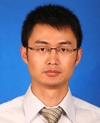 J. Sun (M’10) is an assistant professor of School of Biomedical Engineering, Shanghai Jiao Tong University, China. He received the PhD degree in Electronic and Information Engineering from The Hong Kong Polytechnic University in 2009. His research interests include neuroimaging, brain network modeling, and their applications in stroke, mental disorders and Alzheimer’s disease. Read more
J. Sun (M’10) is an assistant professor of School of Biomedical Engineering, Shanghai Jiao Tong University, China. He received the PhD degree in Electronic and Information Engineering from The Hong Kong Polytechnic University in 2009. His research interests include neuroimaging, brain network modeling, and their applications in stroke, mental disorders and Alzheimer’s disease. Read more
 Nitish V. Thakor (F’97) is a Professor of Biomedical Engineering at Johns Hopkins University, Baltimore, USA as well as the Director of the newly formed institute for Neurotechnology, SINAPSE, at the National University of Singapore. His research interests are neuroengineering, neuroprosthetics, brain machine interfaces, neurochips and devices, and clinical and translational applications. Read more
Nitish V. Thakor (F’97) is a Professor of Biomedical Engineering at Johns Hopkins University, Baltimore, USA as well as the Director of the newly formed institute for Neurotechnology, SINAPSE, at the National University of Singapore. His research interests are neuroengineering, neuroprosthetics, brain machine interfaces, neurochips and devices, and clinical and translational applications. Read more
 Anastasios (Tassos) Bezerianos (SM’08) is a Research Professor in the ECE, National University of Singapore and Senior Principal Research Fellow of Singapore Institute for Neurotechnology (SINAPSE) and Professor at the Medical School of Patras University, Greece. His research interests at large are in Neuroengineering and Systems Medicine and Bioinformatics. Read more
Anastasios (Tassos) Bezerianos (SM’08) is a Research Professor in the ECE, National University of Singapore and Senior Principal Research Fellow of Singapore Institute for Neurotechnology (SINAPSE) and Professor at the Medical School of Patras University, Greece. His research interests at large are in Neuroengineering and Systems Medicine and Bioinformatics. Read more







 Y. Sun (M'13) is a Research Fellow in the Singapore Institute for Neurotechnology (SINAPSE) at the National University of Singapore. Dr. Sun received his PhD degree in Electronics, Electricals, and System Engineering from Loughborough University, UK, in 2011 and the PhD degree in Biomedical Engineering from Shanghai Jiao Tong University, China, in 2012 respectively.
Y. Sun (M'13) is a Research Fellow in the Singapore Institute for Neurotechnology (SINAPSE) at the National University of Singapore. Dr. Sun received his PhD degree in Electronics, Electricals, and System Engineering from Loughborough University, UK, in 2011 and the PhD degree in Biomedical Engineering from Shanghai Jiao Tong University, China, in 2012 respectively.  J. Sun (M'10) is an assistant professor of School of Biomedical Engineering, Shanghai Jiao Tong University, China. He received the PhD degree in Electronic and Information Engineering from The Hong Kong Polytechnic University in 2009. His research interests include neuroimaging, brain network modeling, and their applications in stroke, mental disorders and Alzheimer's disease.
J. Sun (M'10) is an assistant professor of School of Biomedical Engineering, Shanghai Jiao Tong University, China. He received the PhD degree in Electronic and Information Engineering from The Hong Kong Polytechnic University in 2009. His research interests include neuroimaging, brain network modeling, and their applications in stroke, mental disorders and Alzheimer's disease.  Nitish V. Thakor (F'97) is a Professor of Biomedical Engineering at Johns Hopkins University, Baltimore, USA as well as the Director of the newly formed institute for Neurotechnology, SINAPSE, at the National University of Singapore. His research interests are neuroengineering, neuroprosthetics, brain machine interfaces, neurochips and devices, and clinical and translational applications.
Nitish V. Thakor (F'97) is a Professor of Biomedical Engineering at Johns Hopkins University, Baltimore, USA as well as the Director of the newly formed institute for Neurotechnology, SINAPSE, at the National University of Singapore. His research interests are neuroengineering, neuroprosthetics, brain machine interfaces, neurochips and devices, and clinical and translational applications.  Anastasios (Tassos) Bezerianos (SM'08) is a Research Professor in the ECE, National University of Singapore and Senior Principal Research Fellow of Singapore Institute for Neurotechnology (SINAPSE) and Professor at the Medical School of Patras University, Greece. His research interests at large are in Neuroengineering and Systems Medicine and Bioinformatics.
Anastasios (Tassos) Bezerianos (SM'08) is a Research Professor in the ECE, National University of Singapore and Senior Principal Research Fellow of Singapore Institute for Neurotechnology (SINAPSE) and Professor at the Medical School of Patras University, Greece. His research interests at large are in Neuroengineering and Systems Medicine and Bioinformatics. 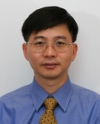 Haoyong Yu is an Assistant Professor of Department of Biomedical Engineering at NUS. He received his PhD in Mechanical Engineering from MIT in 2002. His current research at NUS focuses on robotics for neurorehabilitation, assistive technologies, robotics in surgery, and bio-inspired robots.
Haoyong Yu is an Assistant Professor of Department of Biomedical Engineering at NUS. He received his PhD in Mechanical Engineering from MIT in 2002. His current research at NUS focuses on robotics for neurorehabilitation, assistive technologies, robotics in surgery, and bio-inspired robots.  Chen Gong is currently working towards the Ph.D. degree in Biomedical Engineering, NUS with his supervisor Dr. Yu Haoyong. His current research interests include rehabilitation robots system, compliant actuator and control theory.
Chen Gong is currently working towards the Ph.D. degree in Biomedical Engineering, NUS with his supervisor Dr. Yu Haoyong. His current research interests include rehabilitation robots system, compliant actuator and control theory.  Guo Zhao is a Research Fellow in the Department of Biomedical Engineering, National University of Singapore. He received his Ph.D. degree in Mechatronics Engineering from the Institute of Robotics, Shanghai Jiao Tong University, China, in 2012. His research interests include neurorehabilitation exoskeleton, neuromuscular modeling, and neuromuscular-model based robotic control.
Guo Zhao is a Research Fellow in the Department of Biomedical Engineering, National University of Singapore. He received his Ph.D. degree in Mechatronics Engineering from the Institute of Robotics, Shanghai Jiao Tong University, China, in 2012. His research interests include neurorehabilitation exoskeleton, neuromuscular modeling, and neuromuscular-model based robotic control. 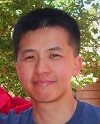 Ngai-Man (Man) Cheung is an Assistant Professor at Singapore University of Technology and Design (SUTD). He received his Ph.D. degree in Electrical Engineering from University of Southern California (USC), Los Angeles, CA. His research interests are image processing and image analysis with application to healthcare.
Ngai-Man (Man) Cheung is an Assistant Professor at Singapore University of Technology and Design (SUTD). He received his Ph.D. degree in Electrical Engineering from University of Southern California (USC), Los Angeles, CA. His research interests are image processing and image analysis with application to healthcare. 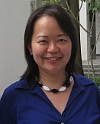 Dawn Chin-Ing Koh is a biomedical scientist with specific interests in neuroscience and cancer research. She has extensive experience using both in vitro (cell lines) and in vivo (mouse models) studies in her research.
Dawn Chin-Ing Koh is a biomedical scientist with specific interests in neuroscience and cancer research. She has extensive experience using both in vitro (cell lines) and in vivo (mouse models) studies in her research.